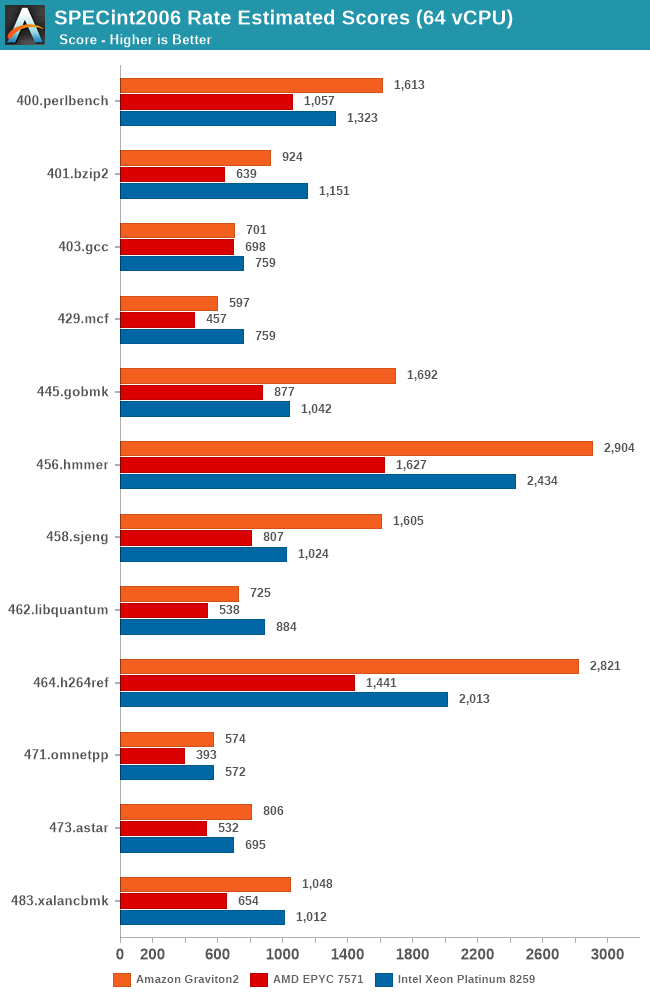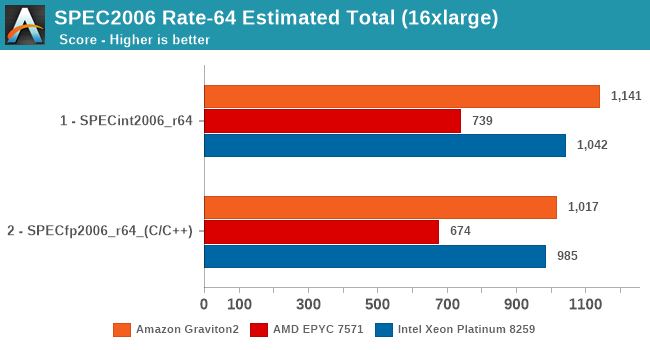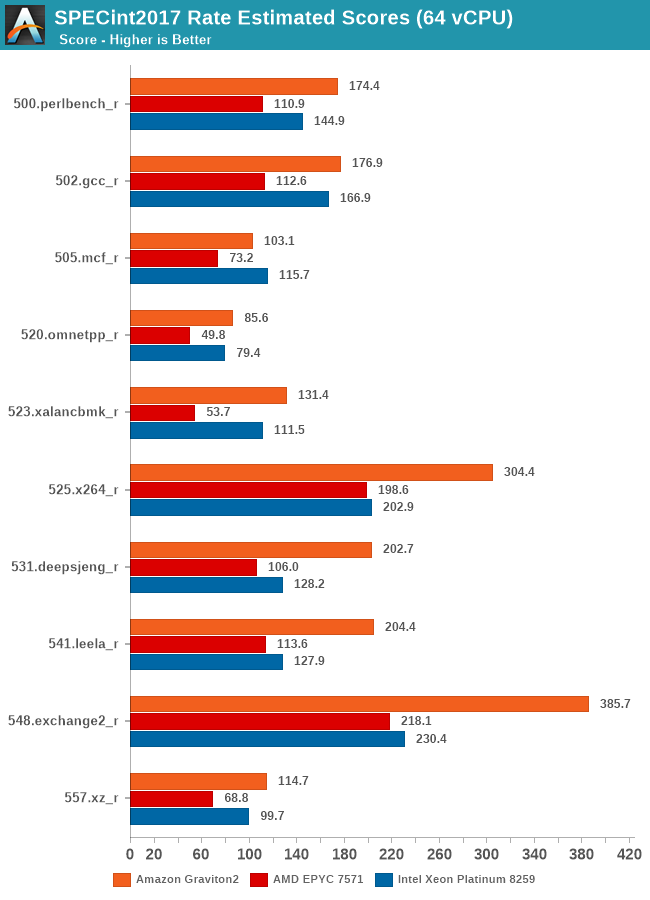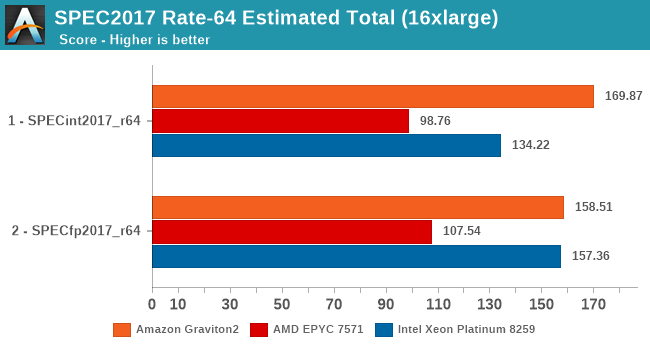Amazon's Arm-based Graviton2 Against AMD and Intel: Comparing Cloud Compute
by Andrei Frumusanu on March 10, 2020 8:30 AM EST- Posted in
- Servers
- CPUs
- Cloud Computing
- Amazon
- AWS
- Neoverse N1
- Graviton2
SPEC - MT Performance (16xlarge 64vCPU)
While the core scaling figures are interesting from an academical standpoint, what’s even more interesting is seeing the absolute throughput numbers compared to the competition. We’re starting off with SPECrate results with 64-rate runs, fully utilising the vCPUs of the EC2 16xlarge instances.
Again, there’s the conundrum of the apples-and-oranges comparison between the Graviton2’s 64 physical cores versus the 32 cores plus SMT setups of the AMD and Intel platforms, but again, that’s how Amazon is positioning these systems in terms of throughput capacity and instance pricing. You could argue that if you can parallelise your workload above a certain amount of threads, it doesn’t matter on whether you can achieve the higher throughput through more cores or through mechanisms such as SMT. Remember, when talking about silicon die area, you could at minimum probably fit 2 N1 cores in the same area than an AMD Zen core or an Intel core (probably an even higher number in the latter comparison).

The Graviton2’s performance is absolutely impressive across the board, beating the Intel Cascade Lake system by quite larger margins in a lot of the workloads. AMD’s Epyc system here doesn’t fare well at all and is showing its age.

It’s particularly in the non-memory bound workloads that the Graviton2 manages to position itself significantly ahead, and here the advantage of having a two-fold physical core lead with essentially double the execution resources shows its benefits.

In the overall SPECrate2006 results, the Graviton2 is shy of Arm’s projection of a 1300 score, but again the Amazon chip does clock in a bit lower and has less cache than what Arm had envisioned in their presentations a year ago.
Nevertheless, the Graviton2 has the performance lead here even against the Intel Cascade Lake based EC2 instances, which is quite surprising given the latter’s cost structure, and indicator of what to come later in the cost analysis.

Arm’s physical core count advantage here continues to show in the execution intensive workloads of SPECint2017, showcasing some very large performance leads in many workloads. The performance leap on important workloads such as 502.gcc again isn’t too great over the Intel system for example – Amazon and Arm definitely could do better here if the chip would have had more cache available.

In SPECfp2017, there’s more workloads in which the Xeon system’s 2-socket setup with a 50% memory channel advantage does show up, able to result in more available bandwidth and thus give the more memory intensive workloads in this suite a good performance advantage over the Graviton2 system. Still, the Arm chip fares very competitively and does put the older AMD EPYC processor in its place, and yes again, we have to remind ourselves that things would be quite different here if we’d be able to include Rome in our charts.

Overall, the Graviton2 system has an undisputed lead in the SPECint2017 suite, whilst just edging out on average the Xeon system in the FP suite, only losing out in situations where the Xeon’s higher memory bandwidth comes at play.










96 Comments
View All Comments
Duncan Macdonald - Tuesday, March 10, 2020 - link
The Apple CPU cores are larger and more power hungry when loaded hard than the CPU cores on the N1. A 64 CPU chip with the high performance cores from the Apple A13 would consume far more power than the N1 and would be quite a bit larger than the N1. The Apple A13 chip (in the iPhone 11) is suited for intermittent load not the sustained use that server type chips such as the N1 have to deal with.arashi - Wednesday, March 11, 2020 - link
Yikesmanedsib1 - Tuesday, March 10, 2020 - link
You are using an Epyc processor that is nearly 3 years old.Surely you should use this years model (or a 64-corer threadripper if you dont have one)
vanilla_gorilla - Wednesday, March 11, 2020 - link
You should consider reading the article and then you would know exactly why they are using those CPU.Kamen Rider Blade - Tuesday, March 10, 2020 - link
The benchmarks feel incomplete. Why don't you have a 64-core Zen2 based processor in it to compare?Even the ThreadRipper 64-core would be something.
But not having AMD's latest Server grade CPU in your benchmarks really feels like you're doing a disservice to your readers, especially since we've seen your previous reviews with the Zen 2 64 core monster.
Rudde - Wednesday, March 11, 2020 - link
Read the article! Rome is mentioned over five times. In short, Amazon doesn't offer Rome instances yet and Anandtech will update this article once they do.Sahrin - Tuesday, March 10, 2020 - link
I may be remembering incorrectly, but doesn't Gen 1 Epyc have the same cache tweaks as Zen+ (ie, Epyc 7001 series is based on Zen+, not Zen)?Rudde - Wednesday, March 11, 2020 - link
They have same optimisations as first gen Zen APUs, i.e. Ryzen mobile 2xxx. Zen+ is a further developed architecture, albeit without further cache tweaks.The cache tweaks in question were meant to be included in the origina Zen, but didn't make it in time. As such one could argue that first gen Ryzen desktop is not full Zen (1), but a preview.
Sahrin - Tuesday, March 10, 2020 - link
The fact that Amazon refused to grant access to Rome-based instances tells you everything you need to know. Graviton competes with Zen and Xeon, but is absolutely smoked by Zen 2 in both absolute terms and perf/watt.It's a shame to see Amazon hide behind marketing bullshit to make its products seem relevant.
rahvin - Thursday, March 12, 2020 - link
Don't be silly. Amazon buys processors in the thousands. There is no way AMD could have supplied enough Rome CPU's to Amazon to load up an instance at each of their locations in the time Rome has been for sale.It typical takes about 6 months before Amazon gets instances online because AMD/Intel aren't going to give Amazon the entire production run for the first 3 months. They've got about 20 data centers and you'd probably need several hundered per data center to bring an instance up.
Consider the cost and scale of building that out before you criticize them for not having the latest and greatest released a month a go. Rome hasn't been available to actually purchase for very long and the Cloud providers get special models and AMD still needs to supply everyone else as well.